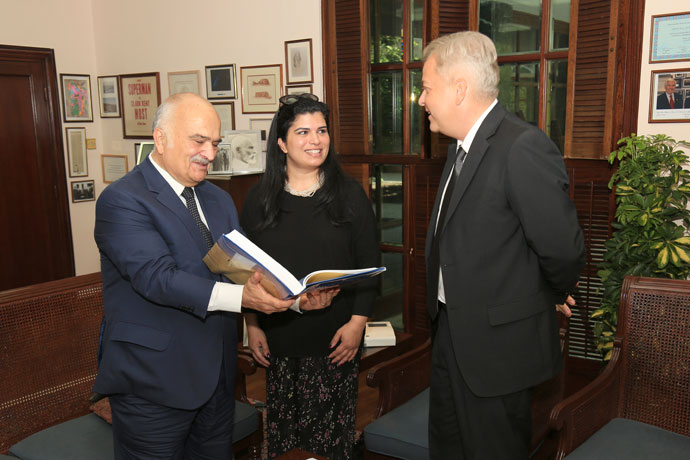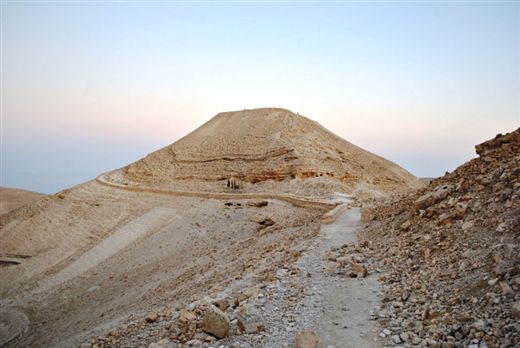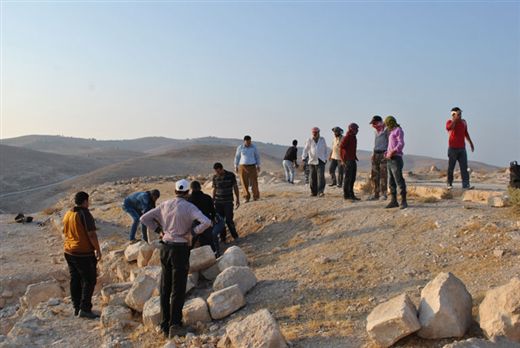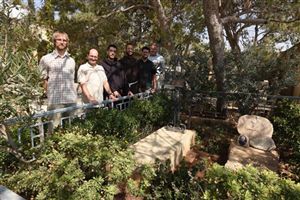
Archeologia
Lo SBF si dedica in particolare alla riscoperta dei luoghi santi del Nuovo Testamento e della Chiesa primitiva in Terra Santa,
allo studio delle fonti letterarie (testi giudaici e cristiani, antichi itinerari in Terra Santa),
alla illustrazione della storia dei santuari della Redenzione.
Conduce ricerche bibliche sotto l’aspetto esegetico, teologico, linguistico e ambientale.
Tra i principali scavi archeologici dello SBF vanno ricordati: Ain Karem, Betania, Betfage, Betlemme, Cafarnao, Cana-Kefer Kenna, Emmaus-Qubeibeh, Gerusalemme (Dominus Flevit, Getsemani, S. Sepolcro, Tomba della Vergine), Herodion, Macheronte, Magdala, Nazaret, Nebo, Tabgha, Tabor.
* Nazaret, è stata oggetto di una lunga indagine archeologica (p. Prosper Viaud 1909, pp. Bellarmino Bagatti - Emanuele Testa 1956-70). Sotto i mosaici della chiesa bizantina e del monastero furono trovati i resti di una sinagoga giudeo-cristiana e graffiti dei pellegrini (tra cui X[AIP]E MAPIA, Ave Maria).
* A Capharnaum, il villaggio di Gesù, fu scavato in diverse riprese (fra Wendelin da Menden 1905-1914, p. Gaudenzio Orfali 1921-1926, pp. Virgilio Corbo - Stanislao Loffreda dal 1968). È venuto alla luce il villaggio con la sinagoga e la casa di Pietro (domus ecclesia). Tra il 2000 e il 2003 p. Stanislao Loffreda ha riaperto lo scavo sul lato orientale della nuova chiesa e sono in corso di pubblicazione i risultati finali di tutte le campagne condotte finora.
Gli scavi di Nazaret, di Cafarnao e del Dominus Flevit, in particolare, hanno aperto una finestra sulla vita delle comunità cristiane di origine giudaica che vissero accanto ai luoghi della redenzione e vi organizzarono il culto prima dell’epoca bizantina.
* Il Memoriale di Mosè Profeta sul Monte Nebo in Giordania fu il primo scavo dello SBF (p. Sylvester Saller 1933-1937) e continua fino ai nostri giorni (p. Virgilio Corbo 1963-1975, p. Michele Piccirillo dal 1976). E’ venuta alla luce una grande basilica e un monastero. Recentemente il Monte Nebo è divenuto il centro delle campagne archeologiche dello SBF in Transgiordania (Macheronte, Umm er-Rasas ecc.).

Josephus, the official Roman historian of the first century Imperial Flavian Dynasty gave a detailed report on “John that was called the Baptist: for Herod slew him […] he was sent a prisoner, out of Herod’s suspicious temper, to Machaerus, the castle I before mentioned, and was there put to death” (Antiquitates Judaicae XVIII 5,2). The historical fact of John’s imprisonment is attested by all the Gospels, and their accounts are consistent with and complement that of Josephus. The fortified Biblical citadel and city of Machaerus in the Trans Dead Sea area was destroyed by the Legion X Fretensis of the Flavian Emperor Vespasian in 71 AD, and later turned into oblivion. Furthermore, the Church History of Eusebius in ca. 324 confirmed Machaerus, as the authentic scene of the imprisonment and beheading of the Baptist (Ecclesiastical History I. 11. 4-6), however the exact location of the historical place had been lost.
HRH Prince El-Hassan bin Talal, Founder and Chairman of the Royal Scientific Society of Jordan, commemorated the historical place of Machaerus with the following words: “The evocative Citadel of Mukawir, or Machaerus to the ancient world, is a site that is redolent with the narrative and wonder of history and faith. It is one of those very special places that seem to exist beyond time and in its own space. It sits in a deeply imbued landscape that brings to life the resting chronicle of belief, devotion and struggle. This abandoned hilltop site with its faded but once-magnificent fortified royal palace, occupies a strategic point overlooking the Dead Sea in the modern Hashemite Kingdom of Jordan. […] This story of death for faith and for love of an ideal makes Mukawir so much more than a fascinating archaeological site. It sits in the landscape of religious memory as a testament and place of pilgrimage, not only for Muslims, but for Christians too. In our country, our beloved Prophet Yehya is Saint John the Baptist by another name. He is the valiant predecessor of Jesus Christ and, indeed, he is rightly considered to be the Patron Saint of Jordan.”
It was on 17 January 1807, after 1735 “lost years” since the 71 AD Roman siege and final destruction of Machaerus, when the German Ulrich Jasper Seetzen arrived to the little Muslim hamlet of Mukawir near the Dead Sea, and the name reminded him for the ancient Greek word of “Machairos” (meaning “sword”, i.e. Lat. Machaerus, It. Macheronte). At the border of the little village he discovered an isolated hilltop, overlooking the Dead Sea, which geographical place and geomorphological formation properly fitted the ancient descriptions of Strabo, Pliny the Elder and especially Josephus, concerning the Hasmonean-Herodian royal castle of Machaerus. The limited surface ruins and the visible geographical evidences met the first century literary references. A hypothesis was born with the possible identification of ancient Machaerus. Meanwhile, the opus delicti, to confirm the 1807 academic theory of Seetzen was only discovered in 1965 by his compatriot, August Strobel, through the discovery of the 3.5-km-long circumvallation siege-wall (a twin monument-structure of the circumvallation around Masada, built by the same Legion X Fretensis), with the hilltop ruins within its epicenter. The only Early Roman siege in the Transjordan region was at Machaerus, where the Zealots took refuge. Strobel published his scientific observations in 1968, and the archaeological excavations and explorations started within some months.
The following field works have been conducted since the discovery of Strobel:
1. 1968: The American-Baptist excavations of the archaeologically virgin Machaerus citadel.
Southern Baptist Theological Seminary, director: Jerry Vardaman (1927-2000)
2. 1973: The German-Protestant survey of the Machaerus circumvallation siege monuments.
Lutheran Augustana Divinity School in Neuendettelsau, director: August Strobel (1930-2006)
3. 1978-1981: The Italian-Franciscan excavations and surveys of Machaerus citadel and lower city.
Studium Biblicum Franciscanum in Jerusalem, director: Virgilio Canio Corbo OFM (1918-1991)
4. 1992-1993: The Italian-Franciscan excavations and monument presentations of Machaerus citadel.
Studium Biblicum Franciscanum (SBF), director: Michele Piccirillo OFM (1944-2008)
5. 2009-2016: The Hungarian excavations, surveys and anastyloses of Machaerus citadel and lower city.
Hungarian Academy of Arts (HAA), director: Győző Vörös
6. 2017-: The HAA-SBF joint excavations and surveys of the Machaerus citadel and lower city.
Joint Archaeological Mission of the HAA and the SBF, director: Győző Vörös
Two introductory articles (published here with the official permission of BAR) to the Machaerus archaeological excavations: are attached below.
Photograph above:
Their Royal Highnesses of the Royal Scientific Society of Jordan, Prince El-Hassan bin Talal (Founder and Chairman), and her daughter Princess Sumaya bint El-Hassan (President) are receiving from SBF Research Professor Győző Vörös the MACHAERUS II volume in the Amman Royal Palace of the Kingdom of Jordan.
The first two excavation-final-report academic-monographs on Machaerus were published in the SBF Collectio Maior series Nos. 53 and 55 in 2013 and 2015 in Milan, Edizioni Terra Santa:
Machaerus I
Machaerus II
The archaeological site is a pilgrim destination for Christianity and Islam today, and also an important historical place for Judaism: one of the memorable scenes of the Gospels. The dramatic events in 29 AD on the Golgotha of Saint John the Baptist that memory are encapsulated among the remaining walls of Machaerus, will be celebrated through its bimillennia in 2029.
2014 SBF - EBAF Jerusalem
An introductory lecture to the Machaerus excavations (the 2014 SBF Dies Academicus lecture):

Continua a Macheronte la spedizione di scavo che anche nel 2017 ha visto impegnati, per la prima volta insieme a livello ufficiale come missione archeologica congiunta, lo Studium Biblicum Franciscanum e la Hungarian Academy of Arts di Budapest. Dal 4 al 28 settembre si è costituita al Monte Nebo e a Macheronte l’equipe di scavo, formata da due membri da parte dell’accademia e due a nome dell’SBF: il direttore, prof. Győző Vörös, e il dr. Tamas Dobrosi per parte ungherese, e i docenti invitati dello Studium, Gianantonio Urbani e Stefano Vuaran.

L’area prevista per le operazioni di quest’anno era l’angolo nord della cittadella, dove negli anni scorsi è stata portata alla luce la quarta torre della fortezza di Erode.
I ritrovamenti di questa campagna hanno riguardato il sistema idrico del periodo erodiano (30 a.C-36 d.C.): canali per lo scolo dell’acqua, un bagno rituale (miqweh, il quinto ritrovato a Macheronte finora), un’ulteriore vasca la cui funzione è ancora da interpretare.
Inoltre si è potuto chiarire meglio il sistema delle mura di cinta asmonee (90-57 a.C.) e romane (44-66 d.C.), individuando la zona dell’ingresso in epoca romana e le aree a ridosso delle mura, riutilizzate dagli zeloti come luoghi di cottura dei cibi.
Non tanto il materiale recuperato è stato importante, quanto l’individuazione di strutture che permettono una comprensione più completa del sito e della sua utilizzazione nelle tre fasi della sua storia: asmonea, erodiana e romana-zelota.
Con questa campagna sono terminate le operazioni nella cittadella: l’obiettivo dei prossimi anni sarà scendere lungo il pendio nord-est della collina, dove si trovava la città bassa, uscendo così dal palazzo di Erode alla ricerca di notizie sulla vita degli antichi abitanti di Macheronte.
Stefano Vuaran
Gianantonio Urbani

Nella foto da sinistra: Thomas, don Gianantonio, fr. Andrea, fr. Junio (guardiano del monte Nebo), don Stefano e il prof. G. Vörös (direttore della Missione Archeologica a Macheronte)


